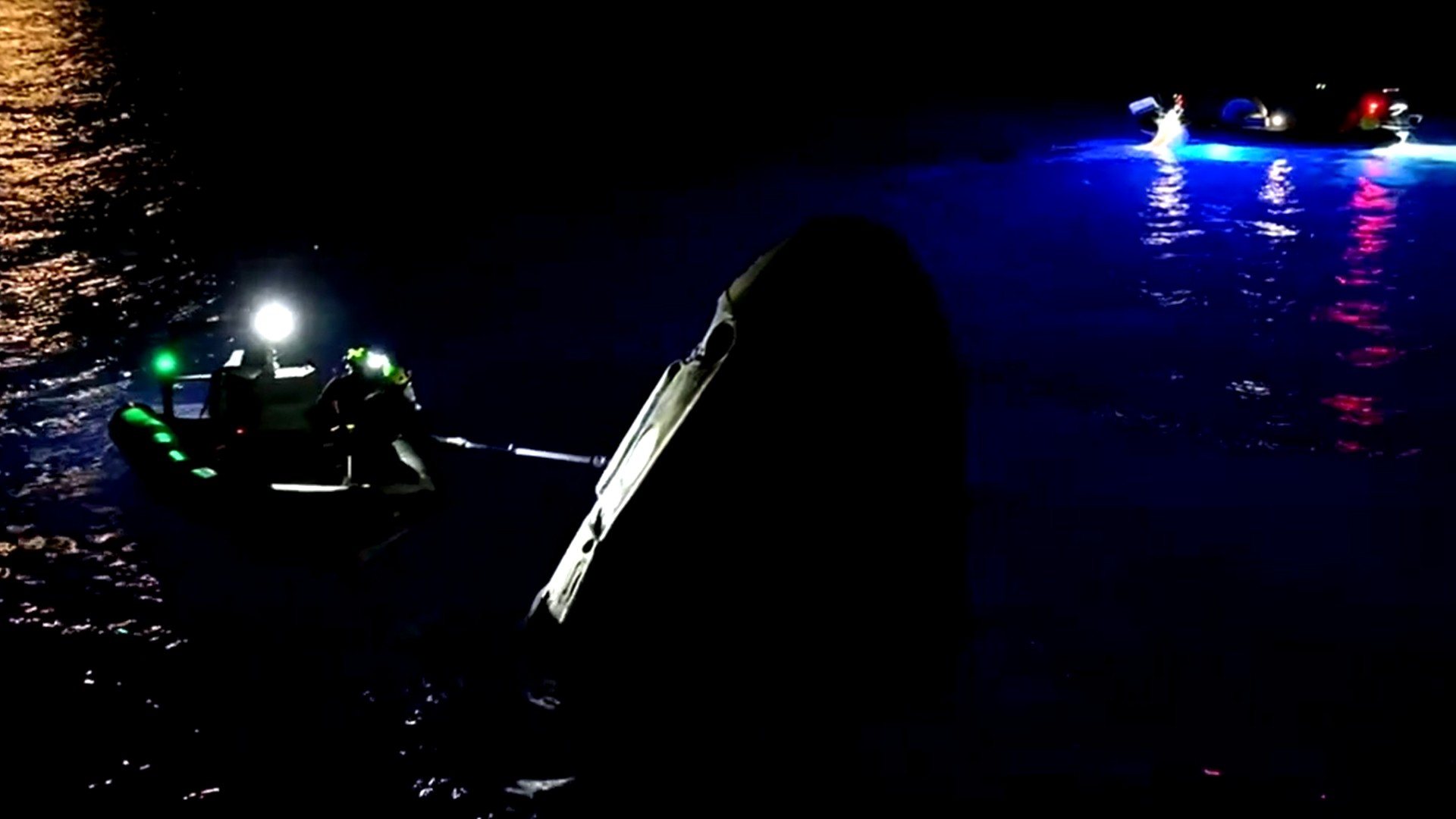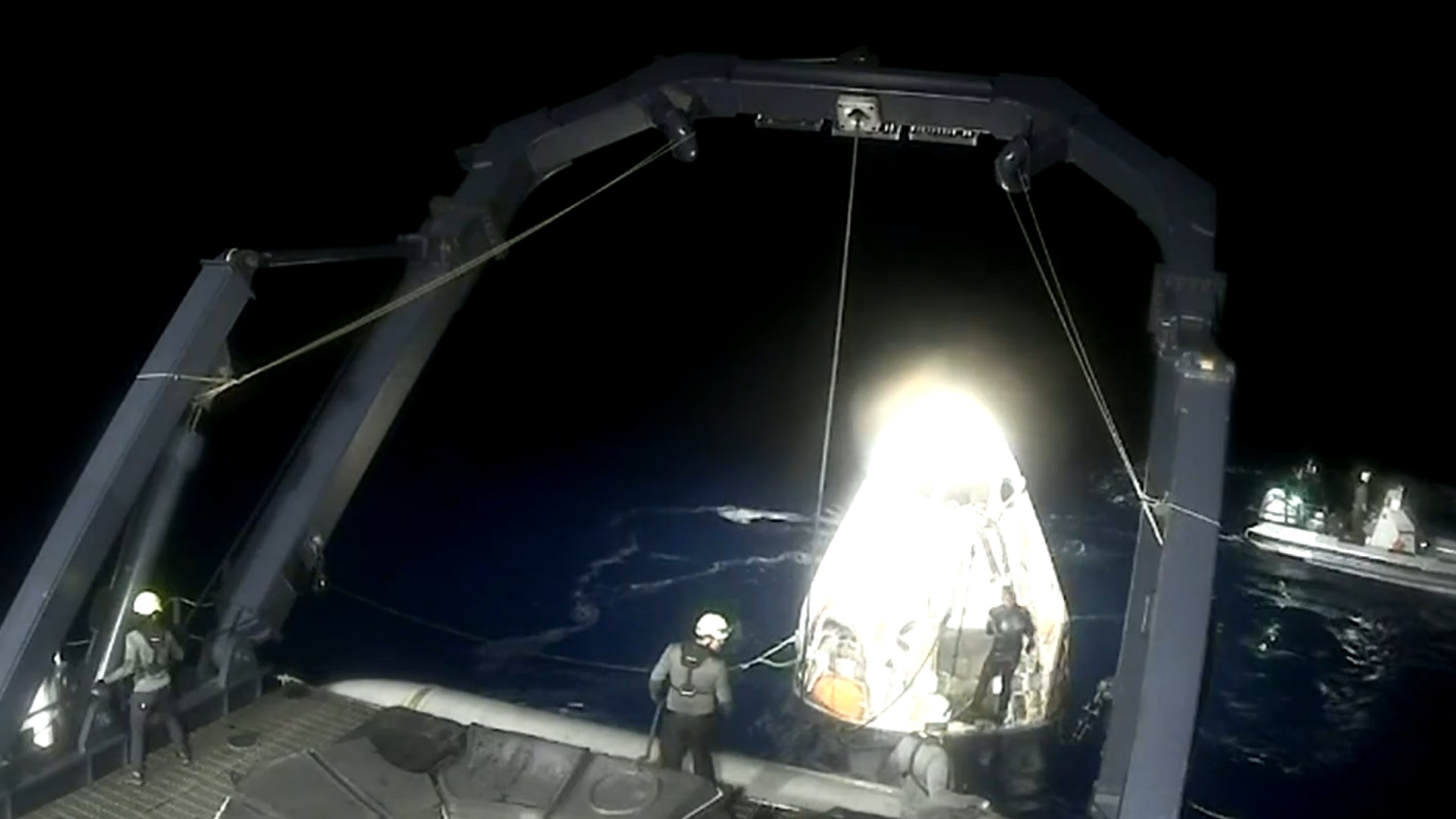Polaris Dawn has landed.
The historic SpaceX astronaut mission — which conducted the first-ever private spacewalk, among other achievements —returned to Earth today (Sept. 15), splashing down safely in the Gulf of Mexico off the coast of Florida at 3:36 a.m. EDT (0736 GMT).
"Polaris Dawn we are mission complete. Thanks for all the big help pulling this mission together," said mission commander Jared Isaacman after the crew splashed down in the ocean.

The reentry was seen by astronauts aboard the International Space Station. "We actually had a pretty neat view of Polaris Dawn entering. All of us were more or less crowded in the cupola watching it," said NASA astronaut Mike Barratt, according to CBS' William Harwood. "That was pretty spectacular for us."

A landmark private flight
Polaris Dawn was funded, organized and commanded by billionaire tech entrepreneur Jared Isaacman. He did the same for SpaceX's Inspiration4 mission in September 2021, the first-ever all-private crewed flight to Earth orbit.
There wasn't supposed to be such a long wait for his second flight: Polaris Dawn had originally been scheduled to launch in 2022, but it was pushed back repeatedly due to the mission's novelty and complexity.

Much of that complexity revolved around the spacewalk. SpaceX needed to develop and test its own extravehicular activity (EVA) suit, for example, and modify Polaris Dawn's Crew Dragon capsule, named Resilience, for the occasion. Such modifications included installing a new hatch structure called Skywalker, which features a ladder, handholds and footholds.
Get the Space.com Newsletter
Breaking space news, the latest updates on rocket launches, skywatching events and more!

Polaris Dawn finally got off the ground this past Tuesday (Sept. 10), sending Isaacman and three crewmates to Earth orbit atop a Falcon 9 rocket. Those companions were Scott "Kidd" Poteet, a former U.S. Air Force lieutenant colonel who served as pilot, and mission specialists Sarah Gillis and Anna Menon, both of whom are engineers at SpaceX.
It didn't take long for the mission to make history. On Polaris Dawn's first day in space, Resilience reached a maximum altitude of 870 miles (1,400.7 kilometers) — higher than any crewed Earth-orbiting spacecraft had ever gotten.
It was also farther from our planet than any astronauts had traveled since the Apollo program ended in 1972. The Apollo astronauts were all men, so Gillis and Menon are now the most well-traveled women in history; no others have gotten farther away from their home planet.

Resilience then lowered its orbit to about 454 miles (730 km) to gear up for the EVA. There were other preparations as well; for instance, the four crewmembers conducted a two-day "pre-breathing" campaign in orbit, purging their blood of nitrogen so they wouldn't get decompression sickness during the spacewalk. (Decompression sickness, also known as "the bends," most famously afflicts scuba divers. It occurs when nitrogen that was previously dissolved in the blood bubbles out due to a rapid decrease in pressure.)
All four astronauts needed to prep in this way, because all four would be exposed to space: Resilience doesn't have an airlock, so when its hatch opened, the entire capsule would feel the effects.

The big moment came early Thursday morning (Sept. 12), when Isaacman popped his head out of the open hatch and climbed up Skywalker to get an unencumbered view of Earth below him.
"SpaceX, back at home we have a lot of work to do, but from here it looks like a perfect world," he said while exposed to the void.
Isaacman stayed outside for nearly eight minutes, according to astrophysicist and satellite tracker Jonathan McDowell. He was followed out of the hatch by Gillis, whose EVA lasted seven minutes and 15 seconds. Neither one floated freely in space; each remained in contact with Resilience, conducting what's known as a "stand-up EVA." Menon and Poteet stayed inside the capsule.
According to the Polaris Dawn team, the spacewalk officially began at 6:12 a.m. EDT (1012 GMT), when the crewmembers started pressurizing their suits, and ended at 7:58 a.m. EDT (1158 GMT), when Resilience was fully repressurized. (Resilience's hatch was open for 26 minutes and 40 seconds, according to McDowell.)
A chief goal of the operation was to test the SpaceX EVA suits, which the company hopes to use on many more missions to Earth orbit and beyond.
"It's not lost on us that, you know, it might be 10 iterations from now and a bunch of evolutions of the suit, but that, someday, someone could be wearing a version of [it] that might be walking on Mars," Isaacman said during a prelaunch press conference on Aug. 26. "And it feels like, again, a huge honor to have that opportunity to test it out on this flight."

Science experiments, tech tests and more
Though the spacewalk was the main highlight, the Polaris Dawn crewmembers performed a variety of other tasks during their five days in orbit.
For example, the mission carried 36 science experiments for 31 different institutions. Much of the orbital work will benefit NASA's Human Research Program, which seeks to learn more about how spaceflight affects the body and mind, and how such impacts can be mitigated.
"Information gathered from Polaris Dawn will give us critical insights to help NASA plan for deeper space travel to the moon and Mars," Jancy McPhee, associate chief scientist for human research at NASA, said in a prelaunch statement.
Polaris Dawn also tested the laser-communication capabilities of SpaceX's Starlink broadband megaconstellation, using the satellites to beam home photos and other data packets.
The astronauts did some cultural and financial outreach as well. For instance, Menon conducted an orbital reading of the children's book she co-authored, "Kisses From Space" (Penguin Random House, 2024). According to SpaceX, proceeds from sales of the book will go to St. Jude Children's Hospital in Memphis. (Inspiration4 also supported St. Jude; that mission ended up raising more than $250 million for the hospital.)
And Gillis played a song from "Star Wars" on the violin aboard Resilience. Her performance was synched with that of orchestras around the world for a music video the Polaris Dawn team put together.
More Polaris missions coming
Polaris Dawn was the first of three planned missions in the Polaris Program, which is funded and organized by Isaacman. Polaris "seeks to demonstrate important operational capabilities that will serve as building blocks to help further human exploration to the moon, Mars and beyond," according to its website.
We don't know much about the next two flights. But the program has announced that Flight 3 will be the first crewed mission of SpaceX's huge Starship Mars rocket.
Starship — the biggest and most powerful launcher ever built — has flown four test flights to date, the most recent of which occurred this past June. SpaceX is still awaiting regulatory approval for the fifth flight, which isn't expected to come until late November.
Join our Space Forums to keep talking space on the latest missions, night sky and more! And if you have a news tip, correction or comment, let us know at: community@space.com.

Michael Wall is a Senior Space Writer with Space.com and joined the team in 2010. He primarily covers exoplanets, spaceflight and military space, but has been known to dabble in the space art beat. His book about the search for alien life, "Out There," was published on Nov. 13, 2018. Before becoming a science writer, Michael worked as a herpetologist and wildlife biologist. He has a Ph.D. in evolutionary biology from the University of Sydney, Australia, a bachelor's degree from the University of Arizona, and a graduate certificate in science writing from the University of California, Santa Cruz. To find out what his latest project is, you can follow Michael on Twitter.









